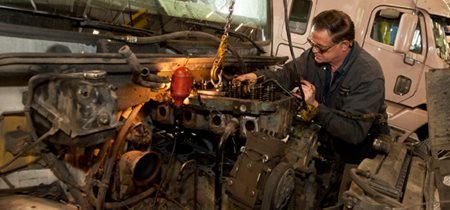There’s a reason we have the old saying “an apple a day keeps the doctor away.”
Preventive care is not just important to your health, but also to the health of your truck. Your truck is a big investment. As owner-operators and small business owners, you know every dollar counts. Not properly maintaining your truck can lead to very costly repairs in the future. While you can theoretically postpone some of the small maintenance items, one item that you don’t want to skimp on maintaining is your coolant system.
Engine coolant is essential in all vehicles, especially trucks. Your trucks are hauling heavy loads over long distances causing a lot of stress and work on your engine.
Mike Goodheart, the director of sales at Penray, says that engine failure from cylinder liner cavitation corrosion is common in the trucking industry even though it can be easily prevented through proper cooling system maintenance. This led Goodheart to work with the American Trucking Associations’ Technology & Maintenance Council to write a comprehensive Recommended Practice for coolant maintenance on trucks.

If a truck’s coolant system is not properly maintained through regular maintenance, cavitation corrosion can cause perforation of wet-sleeve cylinder liners leading to costly repairs. As fuel ignites inside the engine, the cylinder liner vibrates within the block. The outside wall of the liner actually moves away from the coolant resulting in a near-vacuum for an instant. This low pressure causes the coolant to boil forming tiny bubbles. As the liner returns but to its starting position at a very high velocity, it presses the bubbles causing them to implode against the liner wall surface at extremely high pressure. The collapse of these bubbles leave tiny holes in the steel liner. Over time the process will repeat thousands of times eventually leading to the creation of miniature tunnels that allow coolant to drip into the combustion side of the cylinder. If this happens to your truck, you better be prepare to open your wallet wide to pay for the expensive in-frame overhaul of the engine.
Since 2012 the Recommended Practice on coolant maintenance has been available to all truckers in the American Trucking Association’s Recommended Practices (RP) manual. The addition of coolant maintenance was added to the manual when the organizers of the Technology & Maintenance Council’s technician skills competition were looking for clarification on coolant issues, says Goodheart.
Today, the RP contains a glossary of terms, a list explaining the different coolant types available on the market, and the steps a mechanic or technician should take to make sure the coolant in your truck is still doing its job correctly. The RP contains detailed coolant maintenance steps, but themes include:
-
Color of the coolant can help determine what type of coolant is currently in the engine.
-
The clarity and general physical appearance is important to observe.
-
You should determine the freeze point of your coolant to make sure it’s the proper water-to-coolant concentration and fix if needed.
-
You can use a test trip to determine the amount of nutritive additive in conventional coolants and adjust as needed.
There are several types of coolants available on the market today. The RP helps address maintenance for each type of coolant. The five major coolants identified in the TMC Recommended Practice are:
-
Conventional/automotive
-
Fully formulated conventional
-
Nitrited organic acid coolant
-
Straight organic acid (ELC) without nitrites
-
“Universal antifreeze”
In order to learn more about coolant maintenance you’ll have to purchase the TMC Recommended Practices manual from the
American Trucking Association. It will set you back a few hundred dollars, but it can also save you thousands of dollars in the future.
Preventative maintenance for your truck is important, especially coolant as it is vital to the health of your engine.